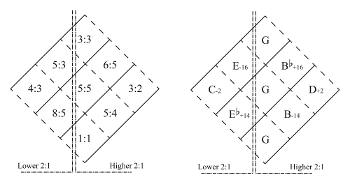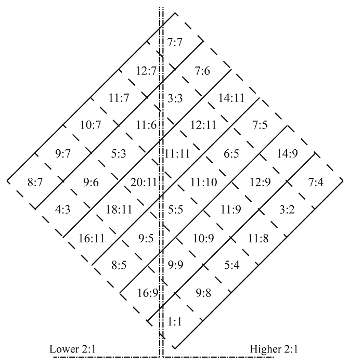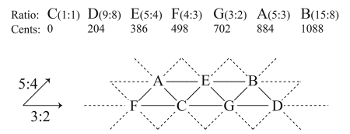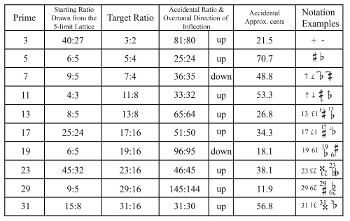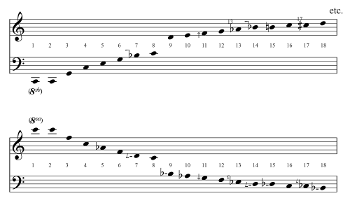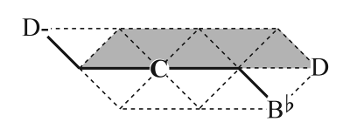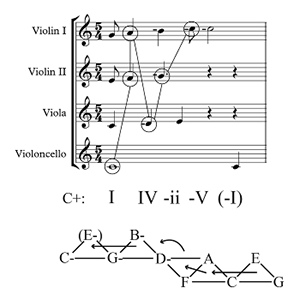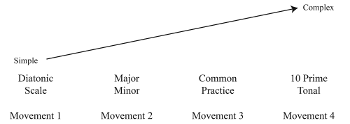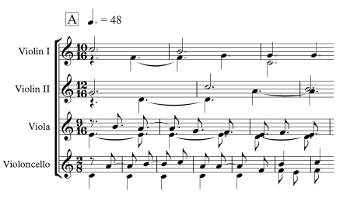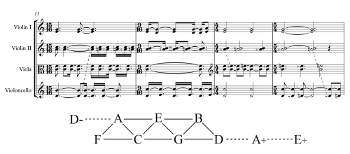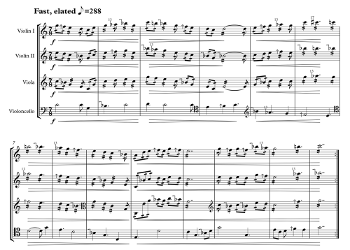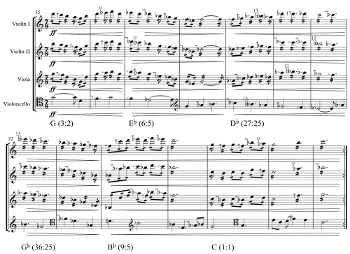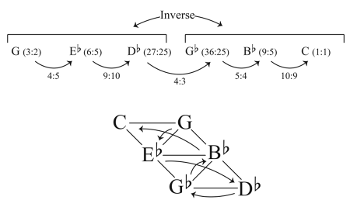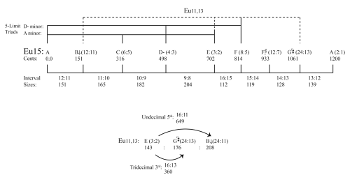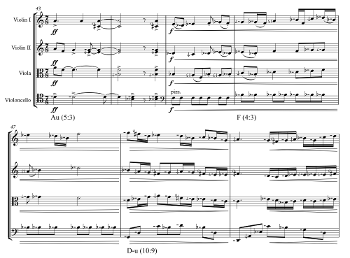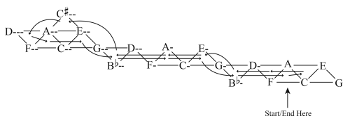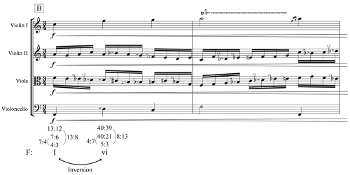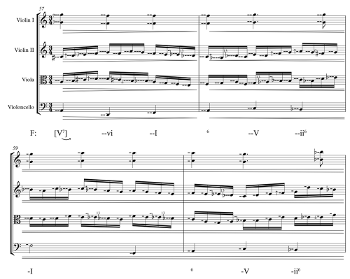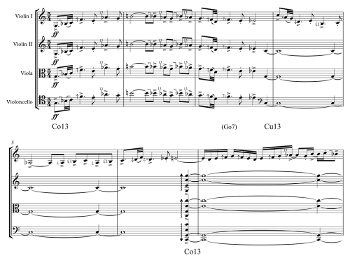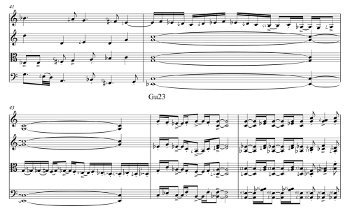Comprehensibility and Ben Johnston’s String Quartet No. 9*
Laurence Sinclair Willis
KEYWORDS: just intonation, Ben Johnston, twentieth-century music, Harry Partch, string quartet
ABSTRACT: Ben Johnston’s just-intonation music is of startling aural variety and presents novel solutions to age-old tuning problems. In this paper, I describe the way that Johnston reoriented his compositional practice in the 1980s as evidenced in his musical procedures. Johnston became aware of the disconnect between Western art music composers and their audiences. He therefore set about composing more accessible music that listeners could easily comprehend. His String Quartet No. 9 gives an instructive example of the negotiation between just intonation and comprehensibility. By integrating unusual triadic sonorities with background tonal relationships, Johnston reveals an evolution of just-intonation pitch structures across the work. This paper provides an example of an analytical method for exploring Johnston’s works in a way that moves beyond simply describing the structure of his system and into more musically tangible questions of form and process.
DOI: 10.30535/mto.25.1.6
Copyright © 2019 Society for Music Theory
Audio Example 1
[1.1] Perhaps the best way to introduce the music explored in this article is for you, the reader, to listen to some of it. So, please listen to Audio Example 1.(1) In some ways this music is very familiar: you heard a string quartet playing tonal music, and they used similar devices of phrasing that we might hear in a classical or romantic quartet. However, there is something not quite right. Why are there so many notes tuned so strangely but played with such commitment? This is the third movement of String Quartet No. 9 (1987–88) by Ben Johnston (1926–), a microtonalist chiefly interested in just intonation. The way we understand, or are invited to understand, these unusual pitches is the central topic of this essay.
[1.2] Between 1959 and 1995, Johnston wrote ten string quartets and most use just intonation. During this period, North American microtonal music came in two varieties: extensions of equal temperament (Joel Mandelbaum, 10 Studies in 31-Tone Equal Temperament, 1963; Easley Blackwood, Twelve Microtonal Etudes, 1980; Ezra Sims, Sextet 1981; etc.) and just intonation (Harry Partch, Delusion of the Fury, 1964–9; La Monte Young, The Well-Tuned Piano, 1964–; James Tenney, Koan, 1984; etc.). While both microtonal approaches extend the gamut of pitches beyond twelve-tone equal temperament, just intonation and extended equal temperaments are conceptually different from one another. Just-intonation tunings eliminate beats(2) between pitches to create just intervals, whereas equal temperaments often approximate just intervals while still beating to some degree. Although we often describe just intonation and equal temperament as categorically separate from one another, this can be somewhat illusory in practice since both may facilitate the exploration of novel sonorities. Certainly, in microtonal communities, neither category is monolithic, and we should be aware of the variety of methodologies just-intonation composers use. Although two composers may share similar aesthetic goals such as pureness and beauty, no standardized just-intonation practice exists, conceptually or notationally. For example, Tenney’s Arbor Vitae (2006) for string quartet uses cent deviations to define pitches and is constructed with an algorithm to guide branching tonalities, whereas Johnston’s “With Solemnity” from String Quartet No. 7 (1984) employs his own extended just-intonation accidentals and slowly transposes through a one hundred and seventy-six note scale using comma pumps.(3) Both of these compositions are just-intonation works but are otherwise relatively unalike. Johnston’s String Quartet No. 9 is different again: the quartet’s tonal pitch structures and recognizable forms expose the abnormality of its intonation, as we heard in Audio Example 1; we find the music at once accessible and strange.
[1.3] Johnston’s microtonal practice changed greatly between the 1970s and 80s, although his conceptual frame for the use of just intonation has always been grounded in a theory of pitch as rhythm. Johnston (Johnston 2006a, 3) believes that by “beginning with the four physical characteristics of musical tone (pitch, timbre, duration, loudness), it is possible to develop an aesthetically well-grounded theory of music as a complex of rhythmic phenomena perceived at different rates of speed.” For Johnston, the most important musical parameters are essentially rhythmic phenomena. Since all relations among musical materials are therefore comparisons between relative velocities, they can be expressed as mathematical ratios. This view of interval leads Johnston (Johnston 2006a, 6) to a straightforward description of consonance and dissonance: “The simpler a ratio, the more consonant the interval, because the period of the resultant rhythm of the two velocities is shorter and less complex.” To achieve these consonances, Johnston uses methods of tuning intervals justly, which he calls Extended Just Intonation (EJI). Johnston believes that twelve-tone equal temperament has perverted the course of music history and the evolution of harmony. He asks questions such as:
How would late romantic chromaticism have developed if untempered extended just intonation had been used rather than twelve-tone equal temperament? Would the atonal movement have occurred? What if one treats a just-tuned scale with atonal techniques? What would a big-band jazz style sound like in extended just intonation? And most important of all, how can the extreme complexity of contemporary life be reconciled with the simplifying and clarifying influences of systems of order based upon ratio scales? (Johnston 1987, 518)
These kinds of questions inform Johnston’s use of his EJI system either to conduct experiments in alternative history or to represent his perception of contemporary life.
[1.4] In his early use of EJI, Johnston wrote mostly serial compositions despite his understanding of serial ordering’s shortcomings. In 1964, he wrote:
The “emancipation of the dissonance” did not solve the problem of harmonic freedom. While rendering permanently obsolete the old black- and white division into consonant and dissonant, it in no sense abolished the tonal hierarchy. On the contrary, it has made more urgent than ever the need for more basic principles of tonal order to integrate ever more complex pitch situations. Serial technique is only an interim solution. Its contributions to musical intelligibility and expressivity need to be subsumed under a larger and less restrictive whole. (Johnston 1964, 75)
Although the first three of Johnston’s string quartets were serial, the fourth quartet signaled a decisive shift in his compositional technique. String Quartets No. 4 (1973) and No. 5 (1979) are theme and variation movements rendered with tonal means.(4) Johnston did not entirely abandon serial ordering at this juncture: his String Quartet No. 6 (1980) features a high degree of serial ordering, as does String Quartet No. 7.(5) Yet, Johnston’s technique was changing. He writes:
I was tired of composing music which interested few listeners beyond other composers and participating in specialized concerts which attracted mainly that audience. I was convinced that composers were at least partly to blame for the ignoring of new music by most performers and audiences. In a spirit of defiance against my own prejudices I began a series of works which thoroughly concealed their complexity and which addressed themselves to a far less specialized audience. (Johnston 1987, 517)
That is to say, Johnston’s interests turned toward composing works that were readily comprehensible. This reorientation away from serial composition focused his efforts toward writing in a style that might broadly be thought of as diatonic and triadic. Johnston writes:
I became interested in the morphological analogy between structures, such as scales based upon triadically generated bases and the much more complex ones generated by using higher overtone relationships. This led to a type of complexity which, in spite of microtones and large numbers of pitches, was organized by principles similar to those of diatonic triadic music. This gave me the possibility of being complex but nevertheless immediately intelligible. (Johnston 1987, 518)
The change in Johnston’s compositional technique from serial to diatonic and triadic is well documented in his string quartets. After No. 6, all of Johnston’s quartets are best described with the term “diatonic triadic music.” Though Quartet No. 7 has its complexities, it seems to balance the diatonic and the serial. Quartets No. 8 (1984–86), No. 9, and No. 10 (1995) are not only diatonic, but explicitly stylistically reference quartet traditions of the classical and romantic periods.(6) The “project” of the late quartets, and Johnston’s stylistic shift toward comprehensibility more generally, has been to bring the just-intonation ideas of Partch into the Western canon and to explore how Western art music may have developed if EJI had been the norm. The reason for the change in Johnston’s compositional technique is twofold: first, he opens his music to a wider audience by making it more readily comprehensible and second, Johnston alters the Western tradition itself to bring it closer to his aesthetic and technical ends. As Johnston (1987, 519) writes, “Nothing can better state my case as a composer than my compositions.” So, to investigate how comprehensibility and tradition interact in Johnston’s music, we must investigate his compositions. I use String Quartet No. 9 as a test case. On first hearing this quartet, one is struck by how different and distinct each movement sounds. Still, some element of cohesion in this work aids our comprehension and helps relate the disparate parts to the whole. Yet, before we can investigate String Quartet No. 9, we first need to understand Johnston’s EJI through his notation. That is the topic of the next section. The reader who is already familiar with this notation may skip ahead to [3.1].
Notation—Beautiful Practicality
Example 1. Partch’s 5-limit tonality diamond, after Partch (1974, 110) also given with pitch names and cent deviations from twelve-tone equal temperament
(click to enlarge)
Example 2. Partch’s 11-limit tonality diamond, after Partch (1974, 159)
(click to enlarge)
[2.1] Before laying out Johnston’s notational system, it is worth quickly reviewing the technical bases of just intonation. Johnston came to know these physical properties of sound through his encounter with Partch, both in print and in person. In 1938, Johnston attended a lecture at Wesleyan College on the relationship between the theories of Hermann von Helmholtz and Debussy’s music. This lecture sparked Johnston’s interest in music theory and just intonation, such that when he read Partch’s (1974) Genesis of a Music, he felt the need to seek out its author. After some mail correspondence between the two men, Johnston studied with Partch from 1950–1 in a practical apprenticeship tuning instruments, learning more about Partch’s theories, and participating in performances.(7) Partch described pitches using whole-number fractions. As has been common for millennia, we may conceive of intervals as an expression of the proportional relationship between two string lengths. If, for example, two strings are of equal thickness and tension, but one is exactly double the length of the other, the pitch interval between them when struck will be an octave. Partch expresses this relationship as the ratio 2:1 (with reference to their vibrating frequencies as opposed to string lengths). Importantly, for Partch, 2:1 is a pitch rather than an interval since all ratios give a specific address for a pitch on his 5-limit tonality diamond (Example 1).(8) On this diamond, all pitches are expressed as ratios between 1:1 and 2:1. For example, rather than writing a perfect fifth as 3:1, Partch writes it as 3:2.(9) These are both examples of a single pitch class, but are not equivalent pitches in our modern conception. In Example 1, each ascending rightward diagonal moves through a just major triad and every descending rightward diagonal is a just minor triad. The tonality diamond is innately dualist in conception, since ratios to the right of the center are generated in the overtonal series (and are therefore called otonal ratios), while those on the left are generated in the undertonal series (and are therefore called utonal ratios). The rich intellectual heritage of the over- and undertonal concept of pitch can be traced back through Rameau, Helmholtz, Öttingen, and Riemann. In all of these previous scholars’ work, utonality has been associated with “minor” and otonality with “major,” though Partch is much more ambivalent about this idea (Partch 1974, 89–90). The breadth of Partch’s system is conceptually infinite, but practically constrained to an 11-limit (i.e., only using prime factors of 11 or lower). Example 2 shows the 11-limit tonality diamond, to give some sense of the higher prime ratios that the system makes available. There is a finer gradation of pitch available in the 11-limit than the 5-limit, and from the 11-limit tonality diamond, Partch derived his famous 43-tone scale. The scales that Partch drew from his tonality diamonds were not analogous to our diatonic scales (although they share many pitches). The difference between Partch‘s scales and those of the common practice should remind us of how ill at ease Partch was with those musical traditions.
Example 3. The just-intoned diatonic shown in ratios, cents, and on a Tonnetz
(click to enlarge)
[2.2] Johnston has expressed how his views differ from Partch’s on musical history and tradition. He writes, “Partch’s determination to throw out almost the whole of Western traditions of composing, performing, theorizing, and bringing music to an audience impressed but also alarmed me. I could see even then how unlikely it would be that his work would even reach a wide public, let alone precipitate changes of so sweeping a nature” (Johnston 1983, 225). The alarm he felt led him to a very different tuning system which remains neutral to its use (i.e., he never advocates for one scale over another).(10) To achieve this flexibility, Johnston developed a series of accidentals that alter familiar just intervals to more complex ratios. Johnston’s starting point is the just-intoned diatonic scale shown in Example 3. This is constructed from two chains of perfect fifths (F–C–G–D and A–E–B) separated by a major third (e.g., F–A). In the representation in Example 3, each triangle of related pitches creates a justly tuned triad from which this diatonic scale is commonly generated. Johnston’s notation system makes no reference to equal temperament but always to the just intoned diatonic scale. This significantly simplifies the notation of just intervals. Johnston’s diatonic scale can be thought of as a subset of a larger, infinite Tonnetz of fifths and thirds. If we extend beyond the diatonic subset of the Tonnetz, we will quickly come across instances of pitches with the same letter name but differently tuned. The most familiar of these tuning differences are between major and minor thirds notated with the
Example 4. Johnston’s accidentals, the 5-limit ration they inflect, the target ratio they bring about, their ratio and cent value
(click to enlarge)
Example 5. The overtone and undertone series of C notated using Johnston’s method
(click to enlarge)
Example 6. A Tonnetz with the syntonic diatonic highlighted in grey
(click to enlarge)
[2.3] Writing a pitch using the symbols
Example 7. Johnston, String Quartet No. 9/I, m. 109
(click to enlarge and listen)
[2.4] Johnston’s chief concern when applying EJI to music is to make it possible to tune a tonal composition justly while maintaining centricity around a single tonal center. This goal is problematic: quite a few common tonal progressions act as comma pumps. A comma pump arises whenever a succession of notes cannot be justly tuned to one another without a comma arising along the way, either within the succession of pitches or between the first and the last pitch. Example 7 shows such a progression from the first movement of Johnston’s String Quartet No. 9. This progression cannot be tuned justly without one interval being a syntonic comma mistuned or else the progression will modulate by one syntonic comma. We can very clearly hear that the final C in the first violin in Example 7 is not tuned as an exact octave of the middle C in the cello. Rather, the interval between the two Cs is an octave narrowed by a syntonic comma. Example 7 also shows this passage on a 5-limit Tonnetz. As we can see, Johnston’s notation clarifies what directions the music takes on the Tonnetz. Rather than skipping from D- minor to G major within the diatonic scale, which would return us to the original tuning of the pitch C, we step outside the limits of the diatonic collection to a C that is lower by one syntonic comma. This is a drift solution to the problem: rather than burying the mistuned interval somewhere inside the progression to privilege the correctness of the octave between starting and ending pitch, we drift away by a syntonic comma. Another solution might have been to shift the tuning of a pitch as the music goes by, but would result in an interval within the succession being mistuned by a syntonic comma.(13) The ability to step outside the normal gamut of tonal music, and to correctly and precisely notate the position of a pitch on the 5-limit Tonnetz, is only one of Johnston’s new resources. His notation also makes it possible to pinpoint any pitch on a 10-dimensional Tonnetz using prime factors up to 31 and so opens the possibility of new, just-intoned sonorities. All of these pitches are rooted to a single referent notationally, which means that modulations to distant keys result in a very busy score. For example, the key of C7 would need a 7 accidental on every pitch of its diatonic scale. Now, with a grasp of Johnston’s notation system, we can progress to inspecting his music. I strongly suggest referring to Example 4 while reading the music in the rest of this essay to aid with comprehension of Johnston’s EJI system if you are unfamiliar with his notation.
Johnston and Macro- and Microscale Relatedness
[3.1] To recap: Johnston’s late quartets are more comprehensible than his earlier quartets enabling EJI to reinvigorate the Western canon. The musical problem is that the four movements of String Quartet No. 9 do not seem to be obviously tied together into a whole. We might unpack why this is a problem. What does comprehensibility and EJI have to do with the “relatedness” of the individual movements of String Quartet No. 9? To answer this question, we might instructively consider Johnston’s views on the relatedness of macro- and microscales in music. We have already seen that Johnston believes many parameters of music to be fundamentally rhythmic in nature.(14) In fact, he explicitly relates the rhythmic organization of macro and micro features of music:
There are in music three possible levels of rhythmic organization, each of which is perceived in a distinctly different manner. These are: (1) the level of phrasing and sectioning, including, at one extreme, motivic construction and, at the other, the overall formal “architecture” of an extended composition; (2) the level of metrical rhythm, having to do with accent grouping and motor response (what is usually meant by “rhythm”); and (3) the level of pitch and timbre, involving microrhythmic phenomena, and the whole question of tonal relationships in music. (Johnston 2006a, 4)
By relating the form, meter, and pitch in such a way, Johnston suggests a relationship between tuning and form. He even more explicitly relates these parameters when discussing musical composition: “The act of musical composition relates the order and pattern of sound vibrations to the order and pattern of musical shapes of larger duration. A composer makes the two interdependent by means of his construction and deployment of musical order on the scale of ordinary rhythmic perception” (Johnston 1964, 56). Johnston invites scrutiny of how “vibrations” may relate to rhythmic perception and perhaps formal parameters. Since Johnston writes that composition is the creation of relationships between sound and larger musical patterns, we might explore the relationship between the macro-form of his compositions and his use of EJI. This relates directly to comprehensibility, since the identification of a deeper unity in a multi-movement work, and a sense of being in a narrative, orients our listening on the local level.
Example 8. The overall just-intonation form of String Quartet No. 9
(click to enlarge and listen)
[3.2] If we want to investigate how the larger proportions of a work relate to EJI, we might first think of the proportions of the wider form and whole number ratios. But in String Quartet No. 9 the relationship is much more straightforward. With each successive movement of the quartet, new microtonal resources are added to the available pitch palate, as shown in Example 8. In this example, we can see that a large-scale development from a just-intonation diatonic scale in the first movement to a sophisticated harmonic language in the final movement is traced throughout the quartet. The rest of this essay will be concerned with enriching Example 8 and adding a deeper perspective of how this large-scale process comes about. My analysis is organized into discussions of each of the four movements in chronological order to highlight the unfolding of this form in time. The analysis presented here is not exhaustive, focusing only on the deployment of EJI in each movement.
Movement 1: Strong, calm, slow
Example 9. Johnston, String Quartet No. 9/I, RH A
(click to enlarge and listen)
[4.1] Most of the first movement of String Quartet No. 9 stays within a single diatonic scale. The vitality of the music is to be found in a web of rhythmic relationships arising from overlaying meters. These are themselves related by the same whole-number ratios that characterize the scale being used (for example, rehearsal A, shown in Example 9).(15) Throughout the movement, new sections begin at each rehearsal mark that are delineated by texture, dynamic, performance technique, and rhythmic profile. Despite their differences, these sections use exactly the same pitch materials: the just-intoned diatonic scale we saw in Example 3, often played in full across all instruments. From this, Johnston draws playful hockets (rehearsals B and E), aggressive and tension building attacks (rehearsals C and D), and calm rocking motions (rehearsal A). These character pieces cohere because of their shared pitch materials and their containment within a striking framing device.
Example 10. Johnston, String Quartet No. 9/I, mm. 11–14
(click to enlarge)
[4.2] We have already seen a comma pump progression from the first movement in Example 7. This takes part in the framing of the movement as a whole: at the beginning and the end of the movement, Johnston introduces the syntonic comma as a tuning correction of the mistuned perfect fifth inherent in the just-intoned diatonic scale. There, the fifth between 9:8 (D) and 5:3 (A) is one syntonic comma narrow of a perfect fifth. If we were to “correct” this fifth, another fifth would then be mistuned by a syntonic comma (either between D and G or between A and E). If we then made a correction to our newly “false” fifth, we would create another error, and so on. Example 10 shows this exact process arising at the beginning of the first movement with dotted lines showing the newly perfected fifths. These intervals are also shown on a Tonnetz. In this passage, the syntonic comma is used to change the harmonic allegiance of a particular pitch. For example, we hear a move between A tuned to 4:3 F and A+ tuned to 9:8 D. By framing the rest of the first movement with the network of potential retunings of pitches within the diatonic, Johnston provides a kernel of systemic drama that impels the rest of the quartet.
Movement 2: Fast, elated
Example 11. The tonal structure underlying the second movement with rehearsal marks and repeat signs
(click to enlarge)
Example 12. Johnston, Quartet No. 9/II, mm. 1–14
(click to enlarge and listen)
Example 13. The scale seen in Ex. 12, the overtone scale of C (Co17), in ratios and cents with additional marking of the 4:5:6 triads found in the scale
(click to enlarge)
[5.1] The second movement immediately introduces very different pitch materials than the first. The movement comprises four repeating sections, as shown in Example 11. The first two sections are in major and the following two are in minor. The major and minor areas have different musical materials, but, as we shall see, use similar pitch structures. Example 12 shows the beginning of the second movement and the introduction of new pitch materials that go beyond the static diatonic of the first movement. Higher primes abound, but the music is more straightforward than it might appear at first. In this opening section, the pitch classes conform to the overtone series of C up to the seventeenth partial—henceforth Co17, where “C” is the generating pitch, “o” refers to otonal (as opposed to “u” for utonal), and “17” refers to the highest odd number involved.(16) Example 13 illustrates Co17. We can see that all adjacent intervals are super-particular (i.e., conform to the ratio form n+1/n) and share a term. This is a natural result of the harmonic series and creates intervals that differ somewhat from equal temperament and the just diatonic scale. For example, the 7th and 11th harmonics sound quite different than their diatonic counterparts. The music at the beginning of the second movement of the quartet moves within this Co17 scale and cannot be said to modulate or change key, ending on a V in m. 14 that acts as a kind of half cadence. The next section begins on V as a proper tonal center, as indicated by the appearance of F7+, the harmonic seventh above G.(17)
[5.2] In the course of the new section (mm. 15–28), the music modulates back from G to C but by a circuitous route. Rather than directly moving by the 4:3 interval to revert from G to C, this motion is obscured by further modulations by 5:4 and 10:9 intervals. Example 14 shows this new section, with the key areas written below. The music passes first to
Example 14. Johnston, String Quartet No. 9/II, mm. 15–28 (click to enlarge and listen) | Example 15. The modulatory scheme of the B section of the second movement along with this motion on a Tonnetz (click to enlarge) |
[5.3] Example 16 shows the next section of the second movement, where Johnston progresses to an A-minor area by generating an undertone scale of E, Eu15, as Example 17 illustrates. In this example, we can see a similar pattern to the scale in Example 15, except that it is upside-down (i.e., the first term of each super-particular ratio in Eu15 descends from left to right, whereas in the Co17 scale this number ascends from left to right). Example 17 shows the Eu15 scale between the octave A 1:1 to A 2:1. This is because the scale is used as A minor in the music (note the A-rooted end of the passage in Example 16). In this way, even though E is the generating pitch of the scale, it stands in the position of the dominant in A minor. Eu15 gives rise to a novel sonority in the place of the “dominant” triad within the scale. Rather than the major 4:5:6 triad we are used to from common-practice tonality, we get a 143:176:208 triad ascending from E with a neutral third and very flat fifth, Eu11,13, which is unfamiliar from a traditional viewpoint. As Example 17 demonstrates, the tri-decimal, or 13-related, third E to
Example 16. Johnston, String Quartet No. 9/II, mm. 29–42 (click to enlarge and listen) | Example 17. The Eu15 scale with the structure of the “dominant” triad, Eu11,13, analyzed (click to enlarge) |
Example 18. Johnston, String Quartet No. 9/II, mm. 43–56 with local tonics indicated beneath the score with their ratios as figured against C as 1:1
(click to enlarge, see the rest, and listen)
[5.4] The final section of the second movement, shown in Example 18, begins in D- minor (Au15) and follows a modulatory excursion (shown underneath the score on a Tonnetz) away from, and back to, D- before the assertion of A minor in the final measures of the movement. Measures 54–56 bring the same sonority as in mm. 40–42 but now asserting A as the tonal center overriding the prevailing key D- minor, where before it straightforwardly affirmed A minor. This sonority takes on an interesting position mediates between A and D- key areas in the last two sections of the movement and suggests Eu15 as the generator of both A minor and D- minor below it (D- is a pitch in Eu15 after all). Stepping back and looking at how the movement unfolds, we see how the music progresses through key areas (Example 11). The inverse relationship between the two large sections (major and minor) is suggestive of a strongly dualist concept of pitch directly tied up with the overtone and undertone series. The dominant pairs are inverted in relation to one another. Where the dominant of C major is G major, the “dominant” of A minor is D- minor, its under-dominant key area. In this movement, we might note that dualism takes place on the background level of key areas and scales, but the deployment of materials in the foreground does not partake in this symmetry. The triad Eu11,13 is used as a kind of dominant chord of A instead of the under-dominant D- (which has a dualistic claim to the syntactical position of the dominant in an utonal system). While 3:2 and 5:4 are still the most privileged tonal intervals in the second movement, the foreground importance of these intervals is problematized by the appearance of the neutral fifth and third associated with primes 11 and 13 in the “dominant” Eu11,13 in the first minor section.
Movement 3: Slow, expressive
Example 19. Johnston, String Quartet No. 9/III, mm. 1–15 with Roman Numeral analysis integrating Johnston’s syntonic comma notation
(click to enlarge and listen)
Example 20. The triadic motion of the first fourteen measures of the third movement represented on a 5-limit Tonnetz
(click to enlarge)
[6.1] In the third movement, Johnston integrates localized tunings within an approximated common-practice tonal language.(18) The musical effect is startling: the normative tonal procedure of functional progression leads to modulation by a syntonic comma. The movement opens with an extended antecedent + continuation.(19) Example 19 gives a Roman numeral analysis of this opening theme. I have integrated Johnston’s accidentals into the Roman numeral analysis. We can see that while the tonic returns at m. 7, it is a syntonic comma lower than the opening tonic and the tonic at m. 8 is a syntonic comma lower again. In m. 10, the tonic returns a syntonic comma higher and by m. 12, the original tuning of the tonic has returned. The motion between I, ii, and V achieves this modulation by syntonic comma. The reason for this is that the supertonic is tuned as a fifth below which itself is tuned 5:6 relative to the tonic. Therefore, rather than being tuned as 9:8 above the tonic, it needs to be tuned as 10:9, the difference between these tunings being 80:81, or the syntonic comma. Because of this, the quartet “sags” down two syntonic commas leading up to the last beat of m. 8. To reverse this, and return us to the proper tonic pitch, Johnston simply reverses the syntax of his progression. Now ii follows V and is tuned as the fifth above , and so as a 9:8 to the tonic. This change in tuning forces to be tuned a syntonic comma higher than it would normally be in order to produce a perfect fifth between (9:8) and (27:16). Example 20 shows the motion of the opening fourteen measures of the third movement on a 5-limit Tonnetz. This representation makes clear how far the progression moves away from the tonic: five perfect fifths and three major thirds at
Example 21. Johnston, String Quartet No. 9/III, mm. 50–51 with the ratio of higher prime passing notes shown beneath the score along with the inverse relationship between the major tonic and minor submediant harmonies
(click to enlarge and listen)
Example 22. Johnston, String Quartet No. 9/III, mm. 57–63 with Roman Numeral analysis integrating Johnston’s syntonic comma notation
(click to enlarge, see the rest, and listen)
[6.2] The opening passage of the third movement is followed by an embellished repeat forming a compound period (mm. 15–28) using the same sequence before a modulatory B section beginning at m. 29. In the B section, the texture changes as violin II and viola begin 16th-note passagework of passing and non-harmonic tones. Following the B section, A′ starts with otonal and utonal inflections integrated as part of the 16th-note passagework. As we can hear in Example 21, which sees the return of A material, the chromatic passing notes are inflected in an otonal way when the chord is major and in an utonal way when the chord is minor. In Example 21, the passing pitches are labelled with the intervallic ratios they form with the dualistic root of the chord.(20) Over the I and vi chords, the chromatic passing notes are exact inversions of one another, which speaks to Johnston’s dualist conception of the major and minor systems. For him, each pitch plays its part in a larger structure in which major and minor are subsidiary and dualistically related parts of the tonal system as a whole. The higher prime passing notes can lead to some striking effects, like the undecimal trill in the first violin in m. 51 in Example 21. This trill is around a quarter tone sharper than we would usually expect and sounds almost out of tune. It is an important moment in the movement since it is the first time such a high prime is integrated into the main melody line, signaling the beginning of the A′, which abounds with higher prime pitches.
[6.3] Example 22 shows the final section of the third movement where the sequence by syntonic comma is further enriched by mobile higher prime passing notes. The music becomes more and more intense, almost cacophonous, until the final measures when the proper tonic is reached, and the inner voices spool out towards the comfort of the final triad. At the resolution into that triad, it seems as though Johnston has found a satisfying solution to the problem of common practice tonality. By traversing the Tonnetz in just intonation while using higher prime sonorities, Johnston heightens the effect of major and minor and enlivens tonality to become locally dynamic and globally unified.
Movement 4: Vigorous and defiant
Example 23. The form of String Quartet No. 9/IV with rehearsal marks and tonality in brackets
(click to enlarge)
[7.1] With the extended tonality of the third movement still resounding in the listener’s ear, the final movement continues to persuasively put it into practice. Every aspect of the tonal writing is suffused with high prime possibilities reaching up to 31, resulting in a finer division of the octave. The movement falls into two halves separated by a short fugato section based on the main motive, as Example 23 shows. This form has some similarities to the second movement, which is also constructed in two equal parts, with inversion being an important pitch structuring principle. The otonal scales in this movement (Example 24) are much more saturated than in the second movement (for example the Co31 scale in mm. 11–14 has many more tones than the Co17 in the second movement). The A section of the movement features a modulation from C to G in mm. 14–17. We see an integration of the rooted scale quality of the second movement with something of the common practice tonal language of the third movement in these measures. In m. 14, a descending Gu31 scale establishes G as a tuning referent, which is followed by a dominant area before a descending Do17 scale forces home the new dominant leading to a proper arrival on G in m. 17.
Example 24. Johnston, String Quartet No. 9/IV, mm. 1–17 with scale resources indicated beneath the score and the modulation to the dominant analyzed using Roman Numerals (click to enlarge, see the rest, and listen) | Example 25. Johnston, String Quartet No. 9/IV, mm. 41–52 with scale resources indicated beneath the score and the modulation to the tonic analyzed using Roman Numerals (click to enlarge, see the rest, and listen) |
[7.2] The two repeating halves of the fourth movement are related by inversion, a device first introduced in the fugato (mm. 27–40). The mirror inversion between mm. 1–17 and mm. 41–50 is shown in Example 24 and Example 25. Wherever in mm. 1–17 the music is otonal (Example 24) it is rendered utonal in mm. 41–50 (Example 25). Nonetheless, the dominant in m. 14 is a major sonority and so is the dominant in m. 50. The dualist and inversional aspects of the music are limited to local sonorities with the quality of the dominant left intact. While inversion between the two sections is an important structuring principle, the global tonic of the work, C, acts as the tonal goal of mm. 41–50, which Johnston enforces with the major diatonic dominant. Even though dualism and inversion are important to the structure of the fourth movement, Johnston still pursues his goal of making his music accessible to his audience, and hence recognizably tonal. Therefore, he maintains the major quality of the dominant. This heightens the sense that the fourth movement integrates the different procedures of the first three movements.
Conclusion—Form, Comprehension, and Aesthetics
[8.1] In the preceding analysis, Example 8 has been embellished with tonal details, moments of high systemic drama, and a developing EJI narrative across String Quartet No. 9. Pitch materials used on the surface of the music and the larger shaping of the quartet as a whole are congruent to one another, which realizes Johnston’s description of musical scales and formal components as versions of the same rhythmic phenomena. The form of the quartet as a whole is one of development and expansion. Harmonically, the growth from a diatonic scale to a sophisticated tonal language reaches its peak in the final section of the third movement when chromatic passing tones heighten the quality of each harmony. Macroharmonically, the enlargement from the diatonic scale to a thirty-one-tone scale finds its culmination in the boisterous final movement. By aligning this development of pitch materials with the forms of the classical string quartet, Johnston renovates the tradition and attempts to answer one of his key compositional questions: How might tonality have developed if EJI were the norm? Using EJI as a structuring principle of his String Quartet No. 9 suggests one answer to that question.
[8.2] Since comprehensibility is the main theme of the present essay, it is worth reflecting on the comprehensibility of the formal components expounded in the preceding analysis. The expansion of microtonal saturation between each successive movement is perhaps the most explicit and immediately recognizable element of the formal plan of the quartet. For example, at the beginning of the second movement, the introduction of new materials is clear. Perhaps the heart of the quartet, its third movement, is where audiences are most aware of the novel approach to tuning. This movement is also the most clearly based on historical models. The effect of this movement is striking in and out of context. The modulations by syntonic comma, and the chromatic passing tones in the final section, can sound rather ‘out of tune.’ Maybe the most extreme of these perceived discordances is the undecimal trill at m. 51 (Example 21). It sounds almost out of place and seems to stand in rebellion against the canonical examples the composition so heavily references. Yet, the more I listen to the third movement, the less strange this trill sounds. Rather, it sounds ever more beautiful, even delicate. By carefully introducing new materials throughout the quartet, movement by movement, the listener is brought into the world of the tuning. By the final movement, the thirty-one tones per octave seem barely remarkable. This is a measure of the success of both the preceding movements in habituating us to the tuning system and the more general project of Johnston’s late quartets. The relative comfort of the finale of String Quartet No. 9 is evidence of Johnston bending tradition to his own aesthetic ends. By his own standards, he could not have done this while writing serial music. The very success of his tuning subversion lies in his use of traditional styles and forms to set off the novelty of EJI. By listening to the quartet and experiencing its microtonal growth, we can answer for ourselves why these tones are tuned so strangely and played with such commitment. We may come to realize that those pitches are just right, and we can learn to hear them intuitively through the practice of familiarizing ourselves with EJI as the quartet unfolds. Through the quartet’s strange and sometimes viscerally striking sonorities, we are led to comprehend for ourselves just what a pitch can be when there are higher limits placed on how it may be tuned.
Laurence Sinclair Willis
McGill University
Schulich School of Music
555 Rue Sherbrooke Ouest
Montreal, Québec
H3A 1E3
laurence.willis@mail.mcgill.ca
Works Cited
Caplin, William Earl. 1998. Classical Form: A Theory of Formal Functions for the Instrumental Music of Haydn, Mozart, and Beethoven. Oxford University Press.
Elster, Steven. 1991. “A Harmonic and Serial Analysis of Ben Johnston’s String Quartet No. 6.” Perspectives of New Music 29 (2): 138–65.
Fonville, John. 1991. “Ben Johnston’s Extended Just Intonation: A Guide for Interpreters.” Perspectives of New Music 29 (2): 106–37.
Gilmore, Bob. 1995. “Changing the Metaphor: Ratio Models of Musical Pitch in the Work of Harry Partch, Ben Johnston, and James Tenney.” Perspectives of New Music 33 (1–2): 458–503.
—————. 2006. “Ben Johnston: A Chronology.” In “Maximum Clarity” and Other Writings on Music, University of Illinois Press, xxv–xxxviii.
Green, Burdette, and David Butler. 2002. “From Acoustics to Tonpsychologie.” The Cambridge History of Western Music Theory, ed. Thomas Christensen, 246–71. Cambridge University Press.
Huey, Daniel. 2006. “Ben Johnston’s String Quartet No. 10: An Investigation of Tuning and Analysis.” MA thesis, University of Iowa.
Johnson, Timothy. 2008. “13-Limit Extended Just Intonation in Ben Johnston’s String Quartet #7 and Toby Twining’s Chrysalid Requiem.” D.M.A. diss., University of Illinois at Urbana-Champaign.
Johnston, Ben. 1964. “Scalar Order as a Compositional Resource.” Perspectives of New Music 2 (2): 56–76.
—————. 1983. “Beyond Harry Partch.” Perspectives of New Music 22 (1/2): 223–32.
—————. 1987. “Extended Just Intonation: A Position Paper.” Perspectives of New Music 25 (1-2): 517–19.
—————. 2006a. “Aesthetic Theory; Philosophical Background for Mathematical Theory; Musical Background for Application of Mathematical Theory 1959–60.” In “Maximum Clarity” and Other Writings on Music, ed. Bob Gilmore, University of Illinois Press, 3–9.
—————. 2006b. Who Am I? Why Am I Here? Ben Johnston Reflects on his Life in Music. Smith Publications.
Klumpenhouwer, Henry. 2002. “Dualist Tonal Space and Transformation in Nineteenth-Century Musical Thought.” The Cambridge History of Western Music Theory, ed. Thomas Christensen, 456–76. Cambridge University Press.
New Dissonance. Oct. 2012. “Ben Johnston: From Helmholtz to Harry Partch.” Youtube video. https://www.youtube.com/watch?v=LB2Xz98rU1A.
Partch, Harry. 1974. Genesis of a Music. 2nd ed: Da Capo Press.
Quint, Johannes. 2016. “Eklektizismus und Experiment.” Zeitschrift der Gesellschaft für Musiktheorie 13 (1): 89–115.
Segnitz, Eric. 2016. Stay Tuned: Celebrating Ben Johnston’s 90th Birthday with his 10 String Quartets. New Music Box. https://nmbx.newmusicusa.org/ben-johnston-celebrating-90-years-with-10-string-quartets/.
Shinn, Randall. 1977. “Ben Johnston’s Fourth String Quartet.” Perspectives of New Music 15 (2): 145–73.
Vogel, Stephan. 1993. “Sensation of Tone, Perception of Sound, and Empiricism: Helmholtz’s Physiological Acoustics.” In Hermann Von Helmholtz and the Foundations of Nineteenth-Century Science, ed. David Cahan, 259–88. University of California Press.
Von Gunden, Heidi. 1986. The Music of Ben Johnston. Scarecrow Press.
Wild, Jonathan, and Peter Schubert. 2008. “Historically Informed Retuning of Polyphonic Vocal Performance.” Journal of Interdisciplinary Music Studies 2: 121–39.
Footnotes
* A version of this paper has been presented at the conference of the Music Theory Society of New York State and the Society for Music Theory Annual Meeting, both in 2016. I extend my thanks to Jon Wild, Robert Hasegawa, and Brenna Langille for their advice, encouragement, and dialogue during the preparation of this research. I also thank the anonymous reviewers, since their comments inspired significant changes to improve the present essay.
Return to text
1. All audio examples of String Quartet No. 9 by Ben Johnston are performed by the Kepler Quartet. From the album Ben Johnston: String Quartets Nos. 2, 3, 4 & 9. New World Records #80637-2 (p) 2006 © 2006 Anthology of Recorded Music, Inc. Used by permission.
Return to text
2. Beats are the interference patterns arising from two closely tuned frequencies. As two sound waves interact, they may constructively reinforce one another, resulting in spikes in volume known as beats. Hermann von Helmholtz was the first to posit beats as a measure of musical consonance. For a more thorough discussion of beats, see (Green and Butler 2002, 254–62) and for a description of how Helmholtz conducted his research see (Vogel 1993, 277–80).
Return to text
3. For an explanation of comma pumps, see [2.4].
Return to text
4. Randal Shinn (1977) has produced an exemplary analysis of String Quartet No. 4, which Johnston (Johnston 1987) endorsed.
Return to text
5. Steven Elster (1991) has written a serial analysis of String Quartet No. 6. Other analyses of individual quartets by Johnston are Huey 2006 and Johnson 2008. A more general assessment of his work can be found in Von Gunden 1986 and some brief analyses found in Gilmore 1995.
Return to text
6. Johannes Quint’s (2016) recent article explores the eclectic nature of Johnston’s borrowings and references in the late quartets.
Return to text
7. See Bob Gilmore’s (2006) chronology of this period. Johnston also talks about his studies with Partch in various interviews such as New Dissonance, Oct. 2012.
Return to text
8. 5-limit denotes the highest prime used in ratios in the system. For example, a 17-limit system could use any ratio involving any of the primes up to 17, but not beyond.
Return to text
9. This is like thinking of a pitch as a pitch class within a conceptual octave. All ratios of the family 3n:2x (where 3n > 2x and n and x are positive integers) are represented by 3:2 even though these ratios would sound in a variety of different octaves.
Return to text
10. See Fonville 1991 for a thorough introduction to Johnston’s notation system.
Return to text
11. There are three exceptions: prime 3 uses the + and - symbols, prime 5 uses
Return to text
12. See Segnitz 2016 for a description of their rehearsal process. First, they are given a midi realization of the score, which they listen to. They then work out the cent deviations and slowly play together to get the intonation right. Finally, they play the quartet closer and closer to performance speed. It is a long process: their recording of Johnston’s quartet cycle took fourteen years.
Return to text
13. The terms “drift” and “shift” are taken from Wild and Schubert 2008.
Return to text
14. See [1.2] for further details.
Return to text
15. While these rhythmic relationships are interesting in and of themselves and deserve analytical attention, they do not pertain to the main arguments of this essay and EJI systemic development across the quartet as a whole, so I only mention them here in passing.
Return to text
16. This is a notation I will use throughout the paper to refer to scales generated in such a way. Another example might be Du13, which is a scale where D is the generating pitch, the other pitches are generated utonally, and pitch classes up to the thirteenth utonal partial are used (the highest odd number partial used). This notation system can extend to include other structures such as triads. For example, we might write an Fo11,13 chord, which is a triad generated otonally from F that includes the eleventh and thirteenth partials only. When the numbers in this notation are separated by a comma, they identify only individual pitches and not a full scale.
Return to text
17. It may seem counterintuitive to see the harmonic seventh above G written as raised by a syntonic comma. The reason for this is that the F that needs to be inflected to a harmonic seventh in comparison to G is a fifth above the
Return to text
18. I refer to Johnston’s tonality as “approximately” common practice, because he uses certain musical procedures that are quite different from common practice (for example the V–II–I progressions found in the opening period described below). This movement rewards Roman numeral analysis, and such analysis helps show how comma pumps and passing tones function. Nonetheless, there are some clear differences between Johnston’s harmonic language and that of the classical music he is stylistically referencing.
Return to text
19. For the analysis of form I use categories developed in Caplin 1998.
Return to text
20. By dualistic root, I am referring to what a Hauptmannian might call the Einheit. In a major chord, this is the root as conventional harmonic theory understands it; in a minor chord, however, it is what modern theory terms the fifth of the chord. See Klumpenhouwer 2002, 460–61.
Return to text
Copyright Statement
Copyright © 2019 by the Society for Music Theory. All rights reserved.
[1] Copyrights for individual items published in Music Theory Online (MTO) are held by their authors. Items appearing in MTO may be saved and stored in electronic or paper form, and may be shared among individuals for purposes of scholarly research or discussion, but may not be republished in any form, electronic or print, without prior, written permission from the author(s), and advance notification of the editors of MTO.
[2] Any redistributed form of items published in MTO must include the following information in a form appropriate to the medium in which the items are to appear:
This item appeared in Music Theory Online in [VOLUME #, ISSUE #] on [DAY/MONTH/YEAR]. It was authored by [FULL NAME, EMAIL ADDRESS], with whose written permission it is reprinted here.
[3] Libraries may archive issues of MTO in electronic or paper form for public access so long as each issue is stored in its entirety, and no access fee is charged. Exceptions to these requirements must be approved in writing by the editors of MTO, who will act in accordance with the decisions of the Society for Music Theory.
This document and all portions thereof are protected by U.S. and international copyright laws. Material contained herein may be copied and/or distributed for research purposes only.
Prepared by Sam Reenan, Editorial Assistant
Number of visits:
12246
